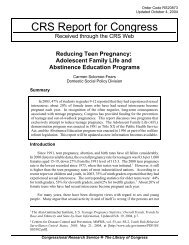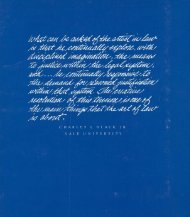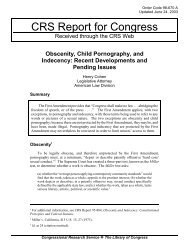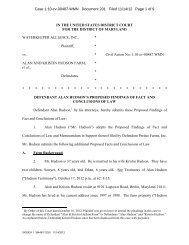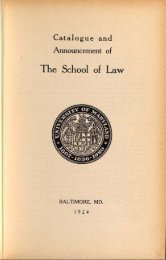journal - University of Maryland School of Law
journal - University of Maryland School of Law
journal - University of Maryland School of Law
Create successful ePaper yourself
Turn your PDF publications into a flip-book with our unique Google optimized e-Paper software.
1990] MONTREAL PROTOCOL<br />
layer over Antarctica. A natural filter, ozone screens out much <strong>of</strong> the<br />
dangerous solar radiation thought to be responsible for increased incidence<br />
<strong>of</strong> skin cancer, crop reductions and even harm to the body's immune<br />
system. Although the size <strong>of</strong> the hole in the ozone layer varies<br />
seasonally and with weather patterns, recently released data has<br />
sparked fears <strong>of</strong> wider depletion than originally postulated.' Researchers<br />
just back from the Arctic report surprisingly high levels <strong>of</strong> the<br />
chemicals thought to precede ozone destruction.'<br />
The prime suspect in the ozone layer's destruction appears to be<br />
chlorine.' High levels <strong>of</strong> chlorine are in turn thought to be the byproducts<br />
<strong>of</strong> chlor<strong>of</strong>luorocarbons ("CFCs"), industrially produced synthetic<br />
compounds <strong>of</strong> varying types and numerous applications. Commercial<br />
issued a study supporting the team's theory. One month later, the United States Environmental<br />
Protection Agency ("EPA") announced a ban on aerosol propellant uses <strong>of</strong><br />
CFCs effective in 1978).<br />
4. Fifteen years ago, scientists assumed ozone depleted only at the Poles and at a<br />
rate <strong>of</strong> about one percent annually. But a new government panel sponsored by NASA<br />
estimates a 1.7 percent loss in the latitudes from Florida to Pennsylvania and three<br />
percent from Pennsylvania north to mid-Canada. These discoveries are alarming and,<br />
as indicated by Senator Max Baucus in an address to the Senate, "[an ozone hole over<br />
the darkened ice-sheet <strong>of</strong> Antarctica when the Sun is low presents a much different<br />
threat than unrestrained ultraviolet radiation pounding on the surface <strong>of</strong> the ocean<br />
when the Sun is high in the sky." 134 CONG. REC. S2110 (daily ed. March 14, 1988).<br />
According to EPA estimates, the increased ultraviolet light from only one percent depletion<br />
will result in a three to six percent increase in the rate <strong>of</strong> most skin cancers.<br />
Gleick, supra note 2, at 30.<br />
5. According to Adrian Tuck <strong>of</strong> the National Oceanic and Atmospheric Administration,<br />
the level <strong>of</strong> lethal chemicals was 50 times higher than normal and comparable<br />
to that found in the Antarctic where dramatic ozone depletion occurs each spring. Arctic<br />
Data Raises Fear <strong>of</strong> Wider Ozone Depletion, Boston Globe, February 18, 1989, at<br />
1, col.l. Scientists are also alarmed by new evidence that the chemistry causing ozone<br />
depletion can take place at higher temperatures than those found in the Arctic circles.<br />
Id.<br />
6. Chlorine destroys stratospheric ozone (03) by "stealing" ozone's third oxygen<br />
atom. The result is a free oxygen atom and a highly reactive radical, chlorine monoxide,<br />
a compound just as destructive as the chlorine element itself. Comment, The Montreal<br />
Protocol: Confronting the Threat to the Earth's Ozone Layer, 63 WASH. L. REV.<br />
997, 1000, n.21 (1988).<br />
Warnings regarding the extraordinarily destructive power <strong>of</strong> CFCs should be<br />
heeded. It has been postulated that one molecule <strong>of</strong> chlorine can destroy as many as<br />
100,000 molecules <strong>of</strong> ozone. If this estimate is accurate, the ultimate effect <strong>of</strong> an annual<br />
release <strong>of</strong> approximately one million tons <strong>of</strong> CFCs would be grave. Ozone Layer<br />
Depletion: Hearings Before the Subcomm. on Health and the Environment <strong>of</strong> the<br />
House Committee on Energy and Commerce, 100th Cong., 1st Sess. 15-16 (1987)<br />
(statement <strong>of</strong> Pr<strong>of</strong>essor F. Sherwood Rowland, Department <strong>of</strong> Chemistry, <strong>University</strong> <strong>of</strong><br />
California at Irvine) [hereinafter Hearings].



